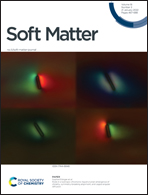DC electric field-driven heartbeat phenomenon of gallium-based liquid metal on a floating electrode†
Abstract
The heart beating phenomenon of room temperature liquid metal (LM) mercury has attracted much attention in the past years, but its research and application are limited because of the low vapor pressure and high toxicity. Here, a fundamental scientific finding is reported that the non-toxic eutectic gallium indium (EGaIn) alloy droplets beat periodically at a certain frequency based on a floating electrode under the stimulation of the direct current (DC) field. The essential characteristics of heart beating are the displacement and the projected area change of the LM droplet. The mechanism of this phenomenon is the self-regulation of interfacial tension caused by chemical oxidation, chemical corrosion, and continuous electrowetting. In this article, a series of experiments are also carried out to examine the effects of different factors on the heartbeat, such as voltage, the volume of the droplet, the droplet immersion depth, the electrolyte solution concentration, the distance of electrodes, and the type of floating electrode. Finally, the heartbeat state and application boundary of the LM droplet under different conditions are summarized by imitating the human life process. The periodic changes of the LM droplet under an external DC electric field provide a new method to simulate the beating of the heart artificially, and can be applied to the research of organ chip fluid pumping in the future.



 Please wait while we load your content...
Please wait while we load your content...